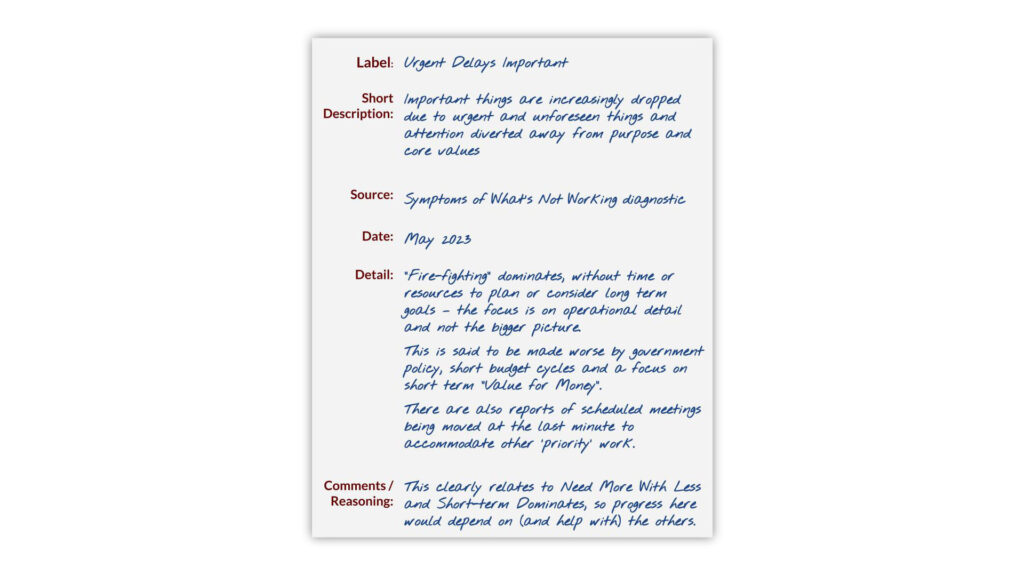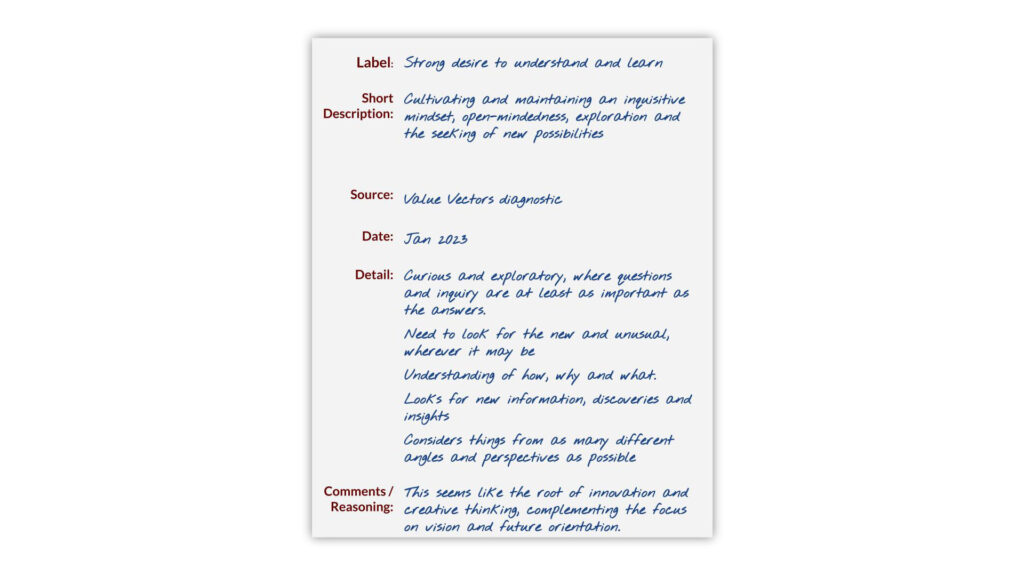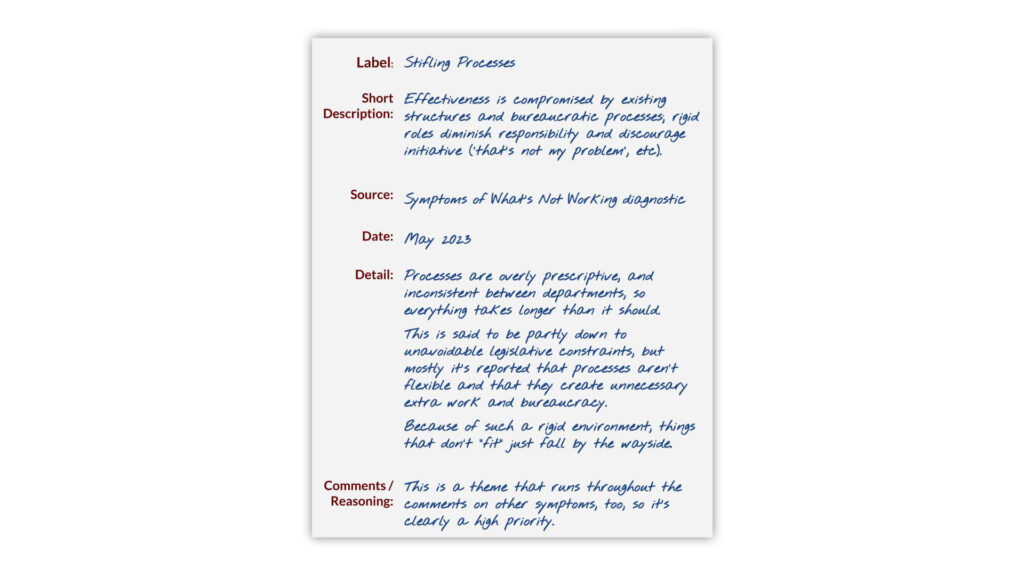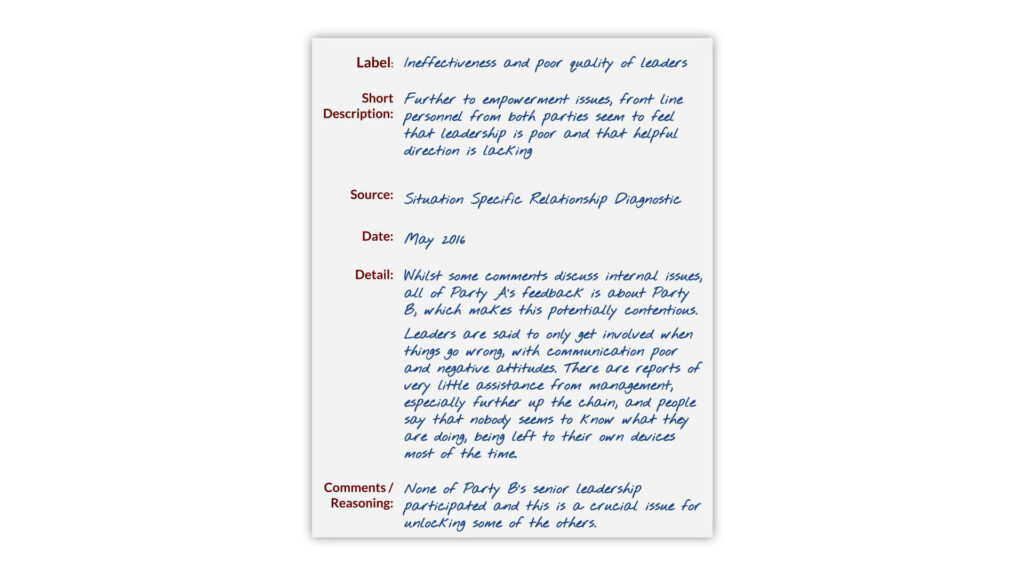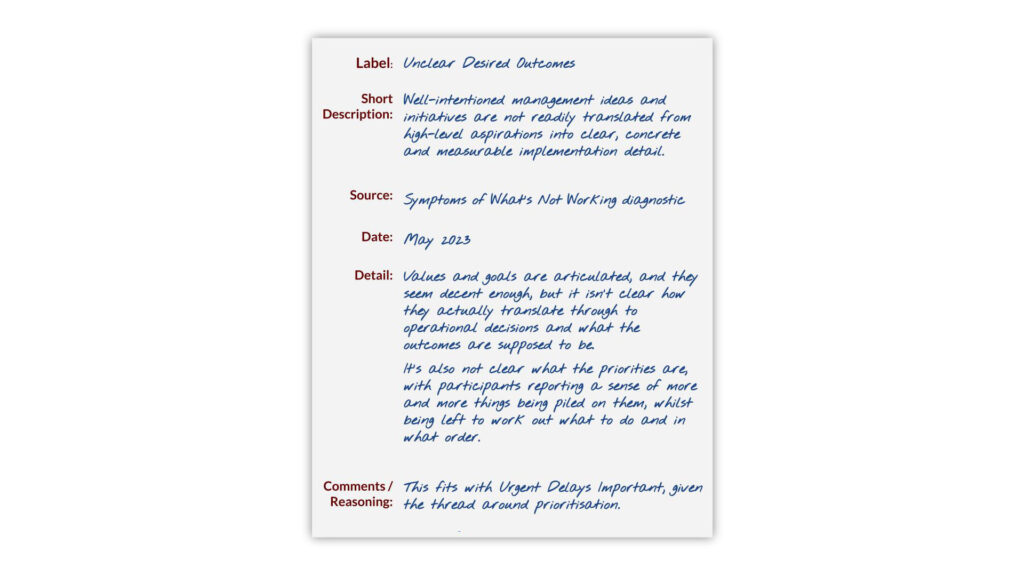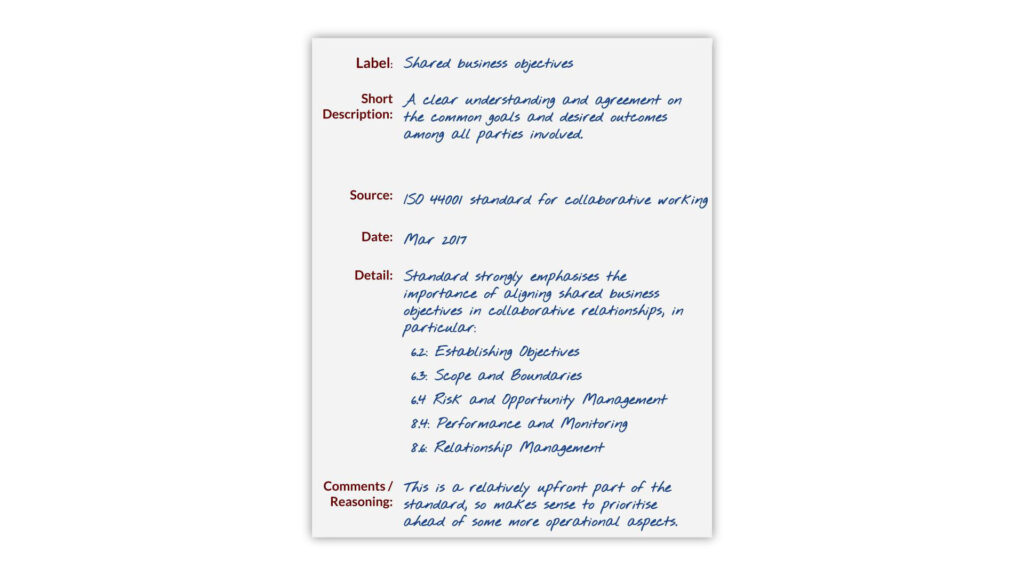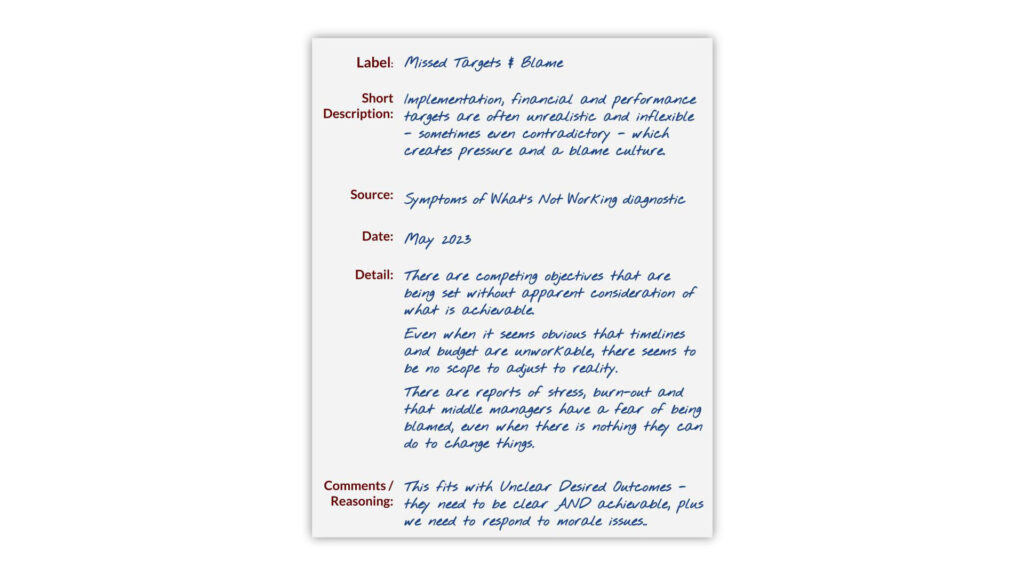What Do Things That Matter Look Like?

Things That Matter is the foundational element of Value Management. But what goes into a Thing That Matters and how do you use them? Here, we find out.
The Things That Matter are at the core of Value Management.
We explain what Things That Matter are as follows:
“The Things That Matter are anything and everything that constitute Value: Value firstly to end customers, and then – from there – Value to your organisation, your employees, your stakeholders and your partners.”
We also explain that:
“…the most crucial Things That Matter are not properly surfaced, not effectively expressed, not collectively owned, not aligned (or the differences managed), not effectively measured, and often all of these: ultimately, they are not working.”
So far, so clear (and the Expectations Curve makes clear what “they are not working” looks like).
But how do you get going with surfacing the Things That Matter? What do Things That Matter look like when they’ve been surfaced and expressed? And what can be done with them next?
Getting Going With Things That Matter
The concept of Things That Matter is so powerful because it is so natural and easy to get started: all anyone has to do is to think of literally anything that matters to their customers, to their project, their team or directly to them.
It does sometimes require overcoming one or more mental “blocks”, though, because Things That Matter as we are now defining them have often not been in focus.
Such things might seem too:
- “Unfamiliar”: they’re not the sorts of things normally in view when “managing” the day-to-day.
- “Controversial”: they will often highlight issues and problems, and if there’s also no immediate next action or clear outcome, that might just seem like criticism.
- “Obvious”: surely someone must be dealing with them already?
- “Vague”: why put attention on something that you can’t (easily) record as a transaction and/or easily measure and act upon and/or get any credit for addressing?
For these reasons, Things That Matter are often surfaced using a Diagnostic to catalyse feedback – taking people into “new” areas and new ways of thinking that give them “permission” to be creative and frank – and they then naturally emerge from its output.
That said, Things That Matter could also/instead be derived from interviews with key personnel or extrapolated from existing materials that express priorities.
(Although note that most contracts, requirements specifications, statements of principles, etc, either don’t cover key Things That Matter or do so at a meaningless level of abstraction – “Honesty”, for example, may “matter”, but it needs to be grounded and applied to something more specific.)
The first step of our Three Steps to Value process encapsulates all this.
What a Thing That Matters Contains
However surfaced, though, the task of capturing a Thing That Matters is to sufficiently capture something that is typically subjective, often vague and not currently expressed.
That means pitching it between the abstract and the actionable, i.e.:
- Capturing enough about it to understand what it is and where it’s come from…
- …and how it’s currently experienced and perceived…
- but without prejudging what to do with it.
We suggest using a template like this (we have a template we share with our clients), and other attributes (such as “Status”) can be added later:
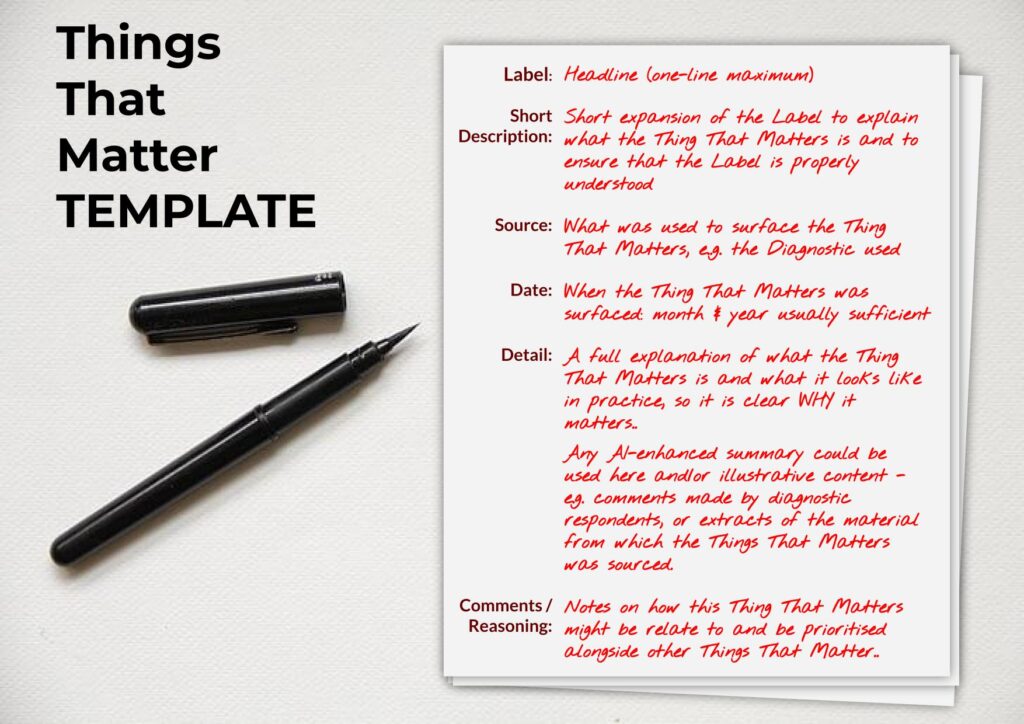
Firstly, the “substance” of the Thing That Matters is captured, at various levels of detail:
- A headline “Label” for quick and easy reference.
- A short description that ensures that this headline isn’t ever misunderstood.
- A full write-up that details exactly what the Thing That Matters is: this may well begin with (and remain illustrated by) particular comments from particular people.
As you do this, you may find it merits splitting into more than one Thing That Matters; you may find yourself merging it with others.
Secondly, “meta data” – the Source and Date – allows for “traceability”, which helps later when measuring and progressing the Things That Matter. You can then:
- Look back to the source material for more information, if needed.
- Show people that what they told you really is being listened-to and acted-on.
Finally, comments and reasoning help with understanding the wider context of each Thing That Matters, and how to prioritise it:
- There may be dependencies on, or connections with, other Things That Matter.
- Some Things That Matter may simply be more important than others.
You can see all this in the second step of our Three Steps to Value process.
Some Example Things That Matter
Putting all these elements together creates a powerful and versatile record of each Thing That Matters.
Here are some examples to illustrate everything we’ve shown so far, and note that whilst they capture the essence of an important issue, goal or concern, they aren’t yet directly actionable (that comes later):
What Can You Do With Surfaced Things That Matter?
The first thing we recommend with the Things That Matter is transparency, and that means “publishing”.
You could use an Intranet, a learning management system – even email – and you could send them all to everyone, or specific subsets to specific groups.
But, however you do it, publishing the Things That Matter:
- Shows people that they are being listened-to (often about things usually left unsaid or ignored).
- Seeds awareness of what the priorities are
- Can help with onboarding new staff.
In situations where there is a formal contract, “publishing” the Things That Matter can include forming a complement to that contract (perhaps even as a formal “appendix”):
- It’s fairly common to set out principles, or values, or desired behaviours, alongside a contract, as some kind of ‘statement of intent’.
- However, such things are typically very vague and/or imposed by senior leaders.
- In contrast here, you have a collectively-authored and collectively-owned set, grounded in reality, and all written up in a clear and easy-to-understand format.
You can then update the list as things change over time (which is where a sense of “Status” comes in), helping to keep the contract relevant and current.
This reflects how the Things That Matter ought to be the primary focus of meeting agendas, both internally and in any relationship – what else should be the focus if not what matters?
This raises the question of prioritisation, though, as experience shows that a “good number” of Things That Matter to focus on at once is somewhere between 10 and 20:
- Fewer than this, and you’re likely missing change opportunities and synergies between Things That Matter.
- More than this, and it’s too much to be manageable.
One option to help here is to convert your list of Things That Matter into a Diagnostic where people can evaluate how important each one is to further refine the overall set: our template allows this process of Diagnostic creation to be fully automated.
However, the most powerful thing you can do with the Things That Matter is to make them measurable, and that means re-expressing them as Value Codes.
But that’s another topic altogether…! (Although it’s what the third step of our Three Steps to Value process is all about.)

